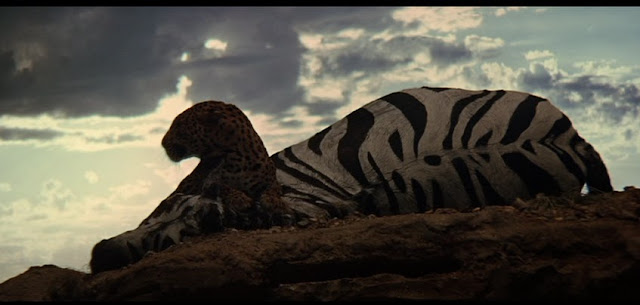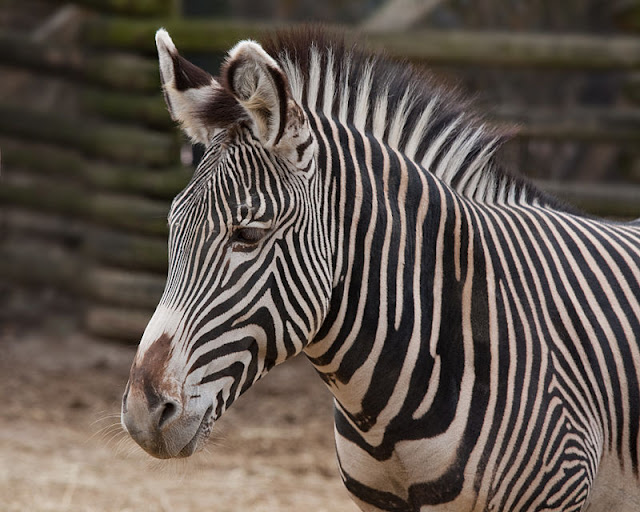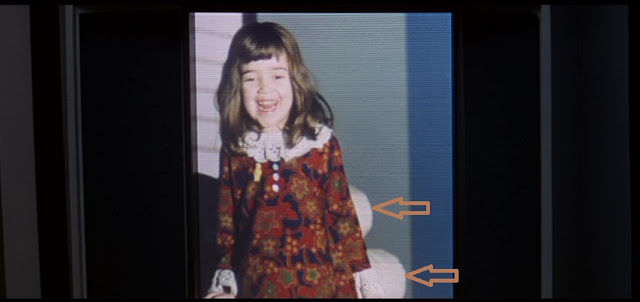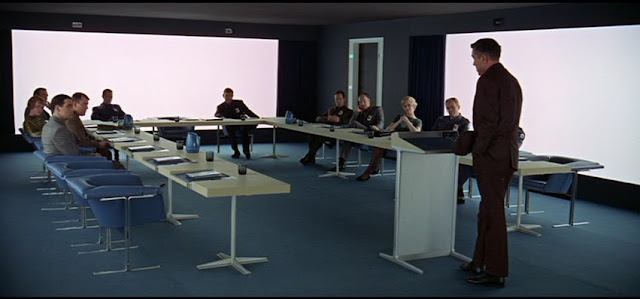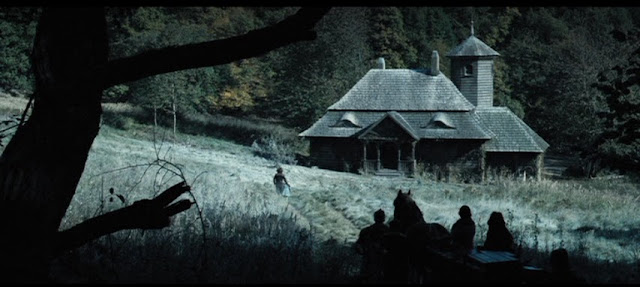Shown at left is the opening title of A Space Odyssey's 'Dawn of Man' segment; note that the setting (i.e., the time period and location) are not specified. Though it's true that Arthur C. Clarke's novel, 2001: A Space Odyssey, which was developed alongside Kubrick's movie, places the Dawn of Man segment in Africa, the fact is that Kubrick had complete control over the movie, and in fact, he set the Dawn of Man at a different geographical location, as described below.
 The pig-like creatures shown in the Dawn of Man sequence, are called tapirs. There is no evidence of tapirs ever naturally existing in Africa; they have, instead, lived in Asia and the Americas. The first true tapirs appeared in the Oligocene Epoch, and by the Miocene Epoch, such genera as Miotapirus were almost indistinguishable from the extant species. It is believed that Asian and American tapirs diverged around 20 to 30 million years ago, and that tapirs migrated from North America to South America around 3 million years ago, as part of the Great American Interchange. Thus, they would have passed through what is now Mexico, at some point during the Pliocene Epoch, which spans the interval from about 5.3 million to 2.6 million years ago. For much of their history, tapirs were spread across the northern hemisphere, where they became extinct as recently as 10,000 years ago.[a] What this means for our analysis is that the Dawn of Man is not set in Africa. At this point, what we must do is determine whether it is set in Asia, North America, Central America, or South America.
The pig-like creatures shown in the Dawn of Man sequence, are called tapirs. There is no evidence of tapirs ever naturally existing in Africa; they have, instead, lived in Asia and the Americas. The first true tapirs appeared in the Oligocene Epoch, and by the Miocene Epoch, such genera as Miotapirus were almost indistinguishable from the extant species. It is believed that Asian and American tapirs diverged around 20 to 30 million years ago, and that tapirs migrated from North America to South America around 3 million years ago, as part of the Great American Interchange. Thus, they would have passed through what is now Mexico, at some point during the Pliocene Epoch, which spans the interval from about 5.3 million to 2.6 million years ago. For much of their history, tapirs were spread across the northern hemisphere, where they became extinct as recently as 10,000 years ago.[a] What this means for our analysis is that the Dawn of Man is not set in Africa. At this point, what we must do is determine whether it is set in Asia, North America, Central America, or South America.
 The skull with tusks shown at left is that of a young American mastodon, a species that inhabited North and Central America during the late Miocene or late Pliocene, up to their extinction at the end of the Pleistocene Epoch 10,000 to 11,000 years ago. Mastodons were predominantly forest dwelling animals, and thus, no living American mastodons would have occupied the relatively barren landscape depicted in the movie. This landscape became barren due to the disappearance of forest areas, which was in turn due to climate cooling during the Pliocene, and remnants of dead mastodons were left behind.[b] We have now narrowed down the setting of the Dawn of Man to North America or Central America.
The skull with tusks shown at left is that of a young American mastodon, a species that inhabited North and Central America during the late Miocene or late Pliocene, up to their extinction at the end of the Pleistocene Epoch 10,000 to 11,000 years ago. Mastodons were predominantly forest dwelling animals, and thus, no living American mastodons would have occupied the relatively barren landscape depicted in the movie. This landscape became barren due to the disappearance of forest areas, which was in turn due to climate cooling during the Pliocene, and remnants of dead mastodons were left behind.[b] We have now narrowed down the setting of the Dawn of Man to North America or Central America. Female and calf American mastodon at the George Page Museum. [Image from the Wikipedia 'Mastodon' page; La Brea Mastodons by daryl_mitchell from Saskatoon, Saskatchewan, Canada, licensed under CC BY-SA 2.0 via Wikimedia Commons.]

The movie's big cat (shown at above left, attacking an ape-man, and above right, sitting over large prey), is commonly assumed to be a leopard, but it is, in reality, a jaguar. The movie's cat has predominantly medium- to dark-orange body coloring (click above images to enlarge), like a jaguar (below left), instead of having lighter coloring, as does the African leopard (below right). Also, notice that the area below the leopard's neck is white, while in the above right and below left screencaps, it can be seen that this area is darker in the jaguar.

Above left: The jaguar, a native mammal of Mexico. [Image from the Wikipedia 'Mexico' page, public domain, via Wikimedia Commons.] Above right: African leopard at the Moremi Game Reserve, Botswana. [Image from the Wikipedia 'Leopard' page; African Leopard 5 by DanH, licensed under CC BY-SA 3.0 via Wikimedia Commons.]
As shown at left, when the movie's jaguar finishes off the ape-man he has attacked, he does so by going for the upper back area of the ape-man's head, instead of, say, for his throat. A jaguar has an exceptionally powerful bite, even relative to the other big cats. This allows it to pierce the shells of armored reptiles and to employ an unusual killing method: it bites directly through the skull of prey between the ears to deliver a fatal bite to the brain.
The leopard inhabits only forested and bushy regions, while the jaguar is known to inhabit regions which include scrublands and deserts, like those of the Dawn of Man segment of A Space Odyssey. The jaguar can also inhabit forests. The jaguar, Panthera onca, is the only existent New World member of the Panthera genus. The jaguar's present range extends from the Southern United States and Mexico across much of Central America and south to Paraguay and northern Argentina. The historic range of the species included much of the southern half of the United States, and in the south extended much farther to cover most of the South American continent. The fossil record points to the emergence of Panthera just 2 to 3.8 million years ago.[c][d][e][f] The foregoing is consistent with the Dawn of Man being set somewhere in North or Central America.
The large striped animal the jaguar is sitting over is an American zebra. This animal is described below.
The American zebra (Equus simplicidens) was a North American species of equid from the Pliocene and the Pleistocene epochs. Remains of it have been discovered in various locations in North American, including in the western part of the Mexican state of Chihuahua, at the Miñaca Mesa. The Miñaca remains date from the North American land mammal age known as the Blancan age.[g] The Blancan age lasted from about 4 million years ago, to 1.9 million years ago. According to Kurten,[h]
"The beginning of the Blancan age is marked by the appearance of a horse of modern type ([the American Zebra]) and by temporary emergence of the Bering land bridge, with resulting intermigration between the New World and the Old...
"The American zebra has been known to science since 1892, when [American paleontologist Edward Drinker Cope] published his description of Equus simplicidens...The name, "simple-toothed", alludes to the enamel pattern of the cheek teeth, which is simple in comparison with that of many other horses...
"[Experts agree that Equus simplicidens] is closely related to the living African species called Grévy's zebra (Equus Grevyi). It is the largest of today's zebras, standing up to six feet at the shoulders. It has large ears, somewhat reminiscent of a donkey, and a long, narrow muzzle. The black stripes are narrower and more densely spaced than in other zebras, which gives the animal a greyish look from a distance. A striking feature is a longitudinal black stripe along the back, separated from the vertical stripes by a white band. We do not know whether this pattern, or anything like it, was present in the American species, but the long narrow muzzle is the same...The other living zebras are more distantly related to the simplicidens-grevyi group."
Note that Kubrick depicts the American zebra as having stripes.
Grévy's zebra stallion. [Image from the Wikipedia 'Grévy's zebra' page; Grevy's Zebra Stallion by Rainbirder, licensed under CC BY-SA 2.0 via Wikimedia Commons.]
Detail of the head of a Grévy's zebra. [Image from the Wikipedia 'Grévy's zebra' page; GreveysZebra25 by Greg Hume, licensed under CC BY-SA 3.0 via Wikimedia Commons.]
-----------------------------------------------------------------------------------------------------------------------------------------------
Kubrick believed that our ape-like ancestors originated in the area of what is now the Mexican state of Chihuahua. The disappearance of forests in this area due to a Pliocene cooling event, forced tree-dwelling apes to become accustomed to walking on land. Kubrick believed that these walking ape-men were our ancestors.
Current science claims that man's ancestors arose in Africa. However, we can make a couple of key observations about the film's ape-men, that together, rule out all of the known species of Hominin which are considered to be, or could have been, ancestors of man, that are known from remains to have existed in Africa during a time span of 4 million to about 1.9 million years ago.
Going by information available from the Smithsonian National Museum of Natural History,[i] we need to consider ten species, seven of which are australopiths (Australopithecus africanus, A. garhi, A. afarensis, A. anamensis, Paranthropus aethiopicus, P. boisei, and P. robustus), and three of which fall under the genus Homo (Homo habilis, H. erectus, and H. rudolfensis). It is not hard to rule all ten of them out, because two of the three species of Homo (H. erectus and H. rudolfensis) had more human-like facial appearances than the ape-men depicted in 2001, and H. habilis and all seven austropiths had short canine teeth, whereas the canines of the ape-men shown in the Dawn of Man sequence are relatively long.
A close-up from the movie of one of our ape-like ancestors (this particular individual is the leader of the film's main 'tribe' of ape-men). If the film's ape-men are members of a known species which was, or could have been, an ancestor of man, instead of a different species theorized by Kubrick, it must be a member of one of the ten species noted above. As mentioned, we can exclude all of them, based on the facial appearance of the film's ape-men (Homo erectus,[j] and H. rudolfensus,[k] both had a more human-like facial appearance than the ape-men of the movie), and for H. habilis and the australopiths, on the dentition of our specimen (you can click on the image to enlarge it, to view the ape-man's teeth more closely): Our man's canines are too long to belong to any of the seven australopiths. The canines of australopiths were small like those of humans.[l] And, Homo habilis had tiny canines.[m]
Another shot showing the long canines of the movie's ape-men.

Above left: Members of our tribe of ape-men eating the meat from a recently-killed tapir. Above right: A close-up of one of the ape-men devouring his piece of tapir meat. Long, sharp canines are ideal for tearing flesh.

Above left: The leader of the tribe of ape-men (foreground) and the members of his tribe, normally walk on all fours. Above right: Some of the members of the tribe are shown walking upright while holding their newly-discovered bone-weapons. The significance of this will be discussed later in the analysis.
a. Wikipedia, 'Tapir'. Web, n.d. URL = https://en.wikipedia.org/wiki/Tapir.
b. Wikipedia, 'Mastodon'. Web, n.d. URL = https://en.wikipedia.org/wiki/Mastodon.
c. 'leopard'. Encyclopædia Britannica. Encyclopædia Britannica Online. Encyclopædia Britannica Inc., 2016. Web. 28 Apr. 2016. URL = http://www.britannica.com/animal/leopard.
d. 'jaguar'. Encyclopædia Britannica. Encyclopædia Britannica Online. Encyclopædia Britannica Inc., 2016. Web. 28 Apr. 2016. URL = http://www.britannica.com/animal/jaguar-mammal.
e. Wikipedia, 'Leopard'. Web, n.d. URL = https://en.wikipedia.org/wiki/Leopard.
f. Wikipedia, 'Jaguar'. Web, n.d. URL = https://en.wikipedia.org/wiki/Jaguar.
g. Studies on Mexican Paleontology. Ed. Francisco J. Vega et. al. Springer, 2006. Google Books, pp. 254, 258. URL = books.google.com.
h. Kurten, Bjorn. Before the Indians. Columbia University Press, 1996. Google Books, pp. 22, 25-26. URL = books.google.com.
i. Smithsonian, National Museum of Natural History, "What does it mean to be human?". Web. 27 Apr. 2016. URL = http://humanorigins.si.edu/evidence/human-fossils/species.
j. As can be viewed at the Homo erectus web page at the Smithsonian National Museum of Natural History web site.
k. As can be viewed at the Homo rudolfensis web page at the Smithsonian National Museum of Natural History web site.
l. 'Australopithecus'. Encyclopædia Britannica. Encyclopædia Britannica Online. Encyclopædia Britannica Inc., 2016. Web. 28 Apr. 2016. URL = http://www.britannica.com/topic/Australopithecus.
m. Wood, Bernard (April 2, 2014). "Human evolution: Fifty years after Homo habilis." nature, International weekly journal of science. Web. URL = http://www.nature.com/news/human-evolution-fifty-years-after-homo-habilis-1.14957.





